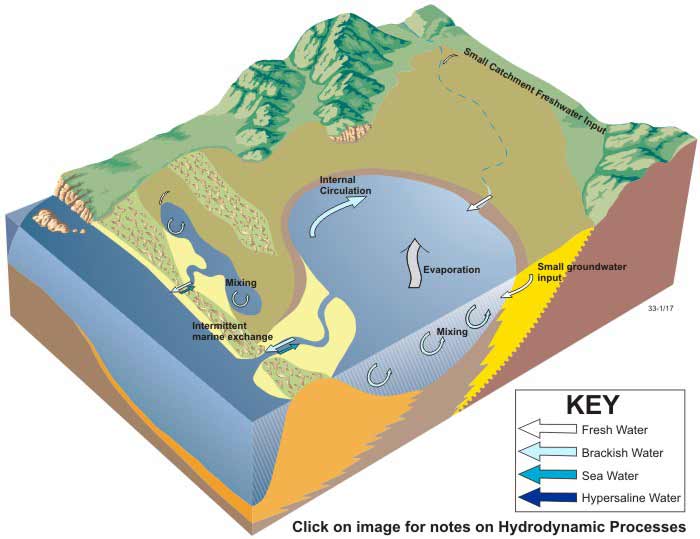
Hydrology processes in coastal lagoons and strandplains
1. Limited freshwater input
Very little freshwater enters from the catchment, which itself may be very small. The quantity of freshwater input can vary seasonally, depending on regional climatic conditions, however is, by definition, very low in coastal lagoons. Many coastal lagoons lack distinct river or creek channels, and receive freshwater from sheet runoff only. Groundwater input may also be significant.
2. Limited exchange with the ocean
Some exchange of marine and estuarine water occurs through the entrance of the coastal lagoon, although this can be restricted by a narrow channel. Entrances of coastal lagoons tend to be intermittently open and closed, and many tend to remain closed for long periods of time, only opening during floods (Ranasinghe et al., 1999). Sub-surface exchange of marine and estuarine water through the permeable barrier may also occur during periods of closure. Coastal lagoons and strandplain-associated coastal creeks that are permanently closed to the ocean exhibit a long-term balance between freshwater inputs, barrier overwashing, and rainfall, and outputs via evaporation, seepage, and evapotranspiration by fringing vegetation (Cooper, 2001).
3. Internal circulation
Internal circulation within coastal lagoons is typically driven by wind-induced currents and internally generated waves. Internal circulation patterns may be altered during extreme high-flow events, and periods of entrance opening. Because the entrance to coastal lagoons and strandplain-associated coastal creeks is usually intermittently or permanently closed, ocean wave and tidal influence is negligible inside the basin (Harris et al., 2003).
4. Evaporation
Evaporation may be significant in certain climatic regions, and can exceed freshwater input in arid climatic regions (see ‘Negative’ wave-dominated estuary conceptual model). During long periods of entrance closure, this may result in hypersaline conditions, and water column stratification.
5. Mixing
Salinity can vary significantly, from brackish conditions to hypersaline, depending upon the amount of freshwater input, climate (aridity), and the frequency and duration of entrance opening. Stratification is common during periods of freshwater input, except during significant internal wind-induced wave activity. Systems with low barriers are more often well mixed and contain saline water due to frequent wash-overs by waves, and landward percolation of seawater through the barrier at high tide (Roy et al., 2001). Some coastal lagoons and strandplain-associated coastal creeks contain elevated water levels in the basin (i.e. they are ‘perched’ systems). If the barrier in these systems is breached, the basin can almost completely drain, resulting in near complete subaerial exposure. As the average depth of coastal lagoons tends to be above the wave base, they tend to be well mixed by wind waves and currents.


